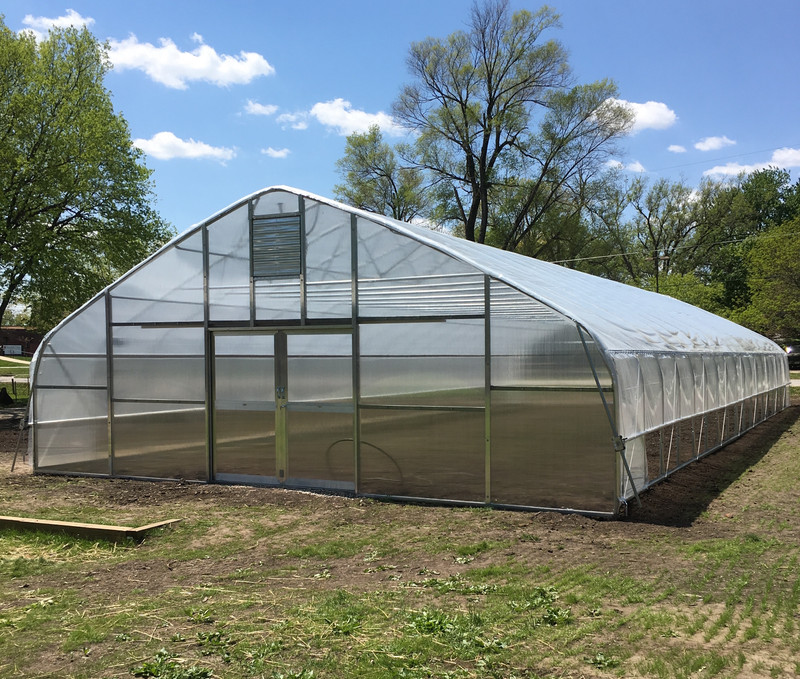Dogpatch Urban Gardens Brings Tunnel Vision Hoops LLC to Des Moines to Build High Tunnel

Before we get into this blog post on Dogpatch Urban Gardens, take a look through some of these wondering resources for Urban Farmers:
Perfect for small lots, 17 ft. wide High Tunnel: 17 ft. wide High Tunnel
Something that can fit in a backyard easily: Backyard structures
More on the Dogpatch Urban Gardens Effort in Des Moines
Dogpatch Urban Gardens (DUG) in Iowa is doing some really important, and really cool work. Although Iowa is a big agriculture state, DUG is making big strides in bringing high quality specialty crops to a city environment.
Located in Des Moines, Iowa DUG has literally stuck a flag into the ground on a plot of land that is highly efficient while visually prevalent; located on a high traffic corner with a newly constructed pole barn style farm stand, DUG can't be missed...and that is exactly what founder and owner Jenny Quiner is intending. In addition to including food grown on-site, the farm stand is acting as a retail outlet for other small and mid-sized farms in the region that may not have access to such a high profile retail sales outlet.
Read More: Caterpillar Tunnel vs Hoop House Low Cost Growing Structures Compared
As a part of their efforts to grow food for the Des Moines community, DUG made the important decision that season extension needed to be a main part of their production plans. This decision was made as a measure of insurance against unpredictable weather, but building a High Tunnel at the farm stand is visual statement that Urban Farming is important and here to stay.
A Visual Statement
Tunnel Vision Hoops LLC worked closely with Practical Farmers of Iowa to develop a structure layout and design that would be well insulated, but would also look good for city dwellers passing by. Since urban agriculture projects are more likely to be under close scrutiny from those unfamiliar with farm projects it was important to DUG that the structure be both functional and visually appealing.
The structure settled on was perfectly designed for high visibility. Ultimately, 8 mm twin wall polycarbonate was used for the end-walls. This type of material is a hard covering that increases the structures insulation. Additionally, this end-wall material just simply looks beautiful, which DUG is hoping draws more attention to their location and increases their customer base.
Components and Features of an Urban High Tunnel
Some of the other components included with their tunnel are listed below:
- 4 Year 6 Mil Anti-Drip Greenhouse Plastic for the first layer, and 4 Year 6 Mil UVA Clear Plastic for the Exterior layer of Double Layer Inflated Greenhouse Plastic. Using a double layer inflated greenhouse plastic system helps create a better insulated structure. In order to keep an insulating layer of air between the two layers of plastic we installed an Inflation Blower Fan, as well as a Jumper Hose that can help move air from one side of the structure to the other side of the structure.
- Superior ventilation for sides and ends. The sides come standard with Roll-up Sides with 7:1 Gear Box Operators, which included 30" Crank Handles for each side. For the end-walls, The Culinary Gardener went with thermostatically controlled options including an intake shutter and an ES Shutter Fan from J&D Manufacturing. These fans move approximately 6,770 Cubic feet per minute. Between the roll-up sides, and the end-wall ventilation, a more manageable climate can be maintained.
- Larger doors for both end-walls; each end has an 8 ft. wide x 7 ft. tall double sliding door. The doors slide on the interior of the structure to prevent wear and tear from inclement weather conditions
Urban Farming Projects across the Country
Most urban centers now have some form of Urban Farm project within their city limits. This has not always been the case, however, as each municipality has chosen to react to the implications of farming differently.
Some cities have welcomed urban agriculture with open arms while others have done their best to block urban farming efforts through difficult to navigate permitting processes, or intentionally worded zoning restrictions.
Through projects like the DUG, positive examples of other urban farming efforts are being made available, and the movement as a whole can continue to grow.
Also Consider Reading: How to Build a Large Hoop House
Also Consider Reading: Questions to Ask Before a Greenhouse Build
